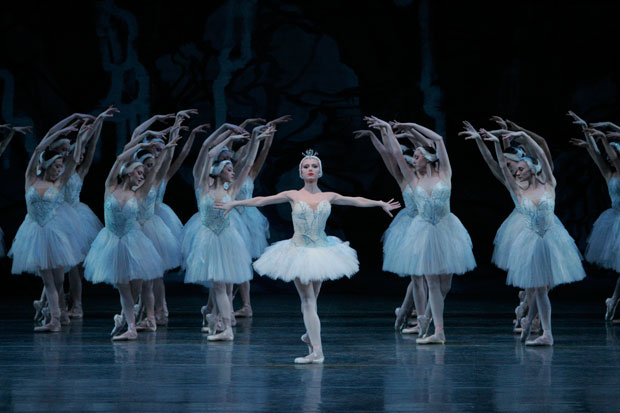
© Paul Kolnik. (Click image for larger version)
New York City Ballet
Swan Lake
New York, David H. Koch Theater
22 September 2015
www.nycballet.com
City Ballet’s Swan Lake has a fair amount riding on it in 2015. The troupe has had a year off from performing Peter Martins’ production, and since then the reputation of the company’s most publicised ballerina – Sara Mearns – has grown exponentially.
On opening night, the audience at the Koch Theater had little to complain about in Mearns’ Odette. Still under 30, Mearns’ rendition of the tragic character is rooted in the contemporary cravings for transparency, visibility and authenticity. Instead of the typical nervous flutterings, she was more angered than anything, darting reproachful glances at Siegfried and his crossbow.
The fear she does show is wrought from intelligence. Unlike Siegfried, performed opening night by a rather smug Tyler Angle, she knows that any liaison risks both their lives. Mearns’ Odette calculates, pauses and thinks before she embraces, the potential death made more real with each hesitation. Her broad, high shoulders work in her favour – tense, anxious – as does her confessional visage, which, in staring out to the audience, could be a frame from a teen’s video diary on YouTube. This is Mearns’ strength and potentially her future weakness, as her Odette is in danger of becoming too human.

© Paul Kolnik. (Click image for larger version)
Swan Lake loses all power, all mystery without mythology. Odette is a riff on the demi god, part human, part possessed. Her spellbound avian nature embodies the divine, immortal powers of magic and sorcery, her emotion, the human condition. It is this cocktail, this bestial tragedy that so beguiles Siegfried, and that is so well suited to the arching aesthetics of classical ballet (Bison Lake would hardly work).
If Odette/Odile (esp. Odette) is more human than animal, the spell is broken. She must be both. Any foreign drama can give us a star-crossed love story, but only ballet gives us swans and sadness. Mearns’ Odette is sometimes so real one is almost expecting her to talk, and not squawk, which could be a danger. This is part of her potency, but she must be cautious in doling out her humanity.
Her Odile, at least on opening night, was vacant. Why her shoulders, neck and face are put to such effective use in Odette and are hardly changed, and thus less effective, in her Odile is confusing. A low chin works for Odette’s cautious musings, but Odile requires some alteration – some are high and haughty, others wily and crafty – Mearns does neither, nor does she find a new avenue that works for her. Maybe it was just an off night, but here’s hoping she finds some new inroads into Odette’s treacherous doppelganger.
As a production, Martins’ staging is underwhelming and inconsistent. In a way, it is not suprrising. City Ballet’s ethos is based on a 20th century notion of ballet stripped down to certain mythical, neoclassical roots. Swan Lake was originally a four-act extravaganza (the full score of original music is longer than most operas), making the entire premise of a City Ballet Swan Lake that fulfills both these roles a bit of an oxymoron. Balanchine didn’t try to compete with a legacy production. Like the Trocks, Balanchine’s is an exercise in brevity, only creating a one-act ballet sourced from the traditional Act II. Martins is overreaching: the costumes, sets and orchestration try to be very City Ballet (garish mid-century color palette, stripped down sets, remixed phrasing), while the entire project exists to satisfy the audience’s dogged desire for ballet’s traditional narrative epics. In short, Martins’ Swan Lake tries to be too many things to too many people.

© Paul Kolnik. (Click image for larger version)
The costumes are a frequent distraction: how Amar Ramasar keeps a straight face in his purple satin cheerleader skirt in the Act II’s Russian Dance, is a miracle. Draped in a slinky harem pants and baring a midriff, his partner, Rebecca Krohn, looks like an Erte illustration – all 1920s exoticism, while the courtiers donn Renaisannce ruffs. The orchestration is different, often emphasizing pulsating strings rather than woodwinds – sometimes burying Tchaikovsky’s swan song. It’s not bad, but it makes it adds to the fussiness of the package, and the difference feels forced rather than fluid.
Across the two acts, the traditional choreography is injected with spikes of jazzy hands, windmill arms, jerky backbends and awkward turns. While some might be flaws in execution (all but Daniel Ulbricht’s jester turns suffered on the night), the attempt to marry traditional Swan Lake motifs with those of the Balanchine vocabulary is, here, a jagged arrangement, somehow both erratic and prosaic.
The most telling proof of this were the four cygnets. Martins barely changes this, and Jacqueline Bologna, Baily Jones, Alexa Maxwell and Claire Von Enck were the most flawless performers of the evening. Floppy pointework abounded opening night until they showed up: fleet footed, well-timed, synchronized, unflappable and fast. It was here, in this stretch of iconic choreography that City Ballet looked its finest, proudly exhibiting the no-frills technical skills for which it is famous, and giving no hint of the choreography’s true unwieldiness. No other troupe could have performed it this way. Maybe in the case of Swan Lake, City Ballet’s notable qualities – speed, clarity – are best amplified through tradition. Another example of City Ballet’s triumphant take on classicism was also seen in Antonio Carmena’s vigorous performance in the Act I pas de trois, which was, if not exactly perfect, rather radiant.












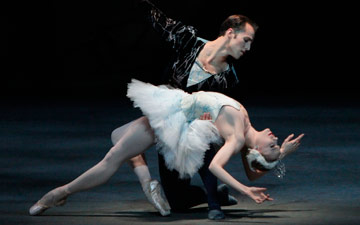
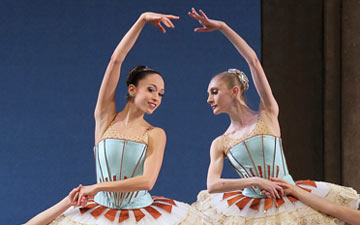
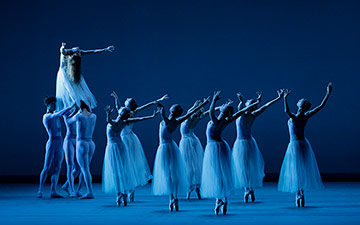

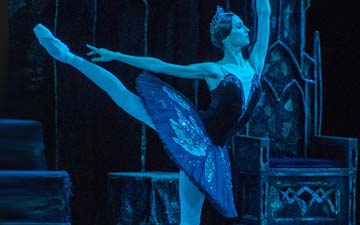
You must be logged in to post a comment.